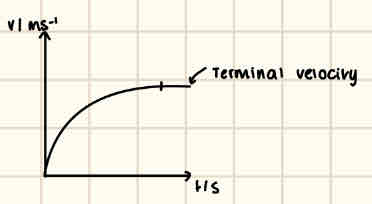Non uniform acceleration
1/4
Earn XP
Description and Tags
Name | Mastery | Learn | Test | Matching | Spaced |
|---|
No study sessions yet.
5 Terms
Define non linear motion
Motion when acceleration is not constant
What are factors that effect drag?
The object’s speed, cross sectional area, shape, texture and the density of fluid
Describe terminal velocity
Weight remains constant.
The acceleration of the object is greatest just as it’s dropped from rest, making the resultant force the greatest too.
As the object continues to freefall, drag increases causing the resultant force to decrease as weight and drag oppose each other.
Eventually drag will be equal to weight making the resultant force = 0, which also means there’s no acceleration. The object has reached terminal velocity.
The object will continue travelling at this velocity for the duration of the flight until it reaches the ground.
What is drag directly proportional to?
Drag ∝ Speed²
How do we determine terminal velocity in fluids?
We drop a steel ball bearing into a viscous fluid.
1) A measuring cylinder is filled with a viscous fluid like glycerine. Rubber bands are tied around the cylinder at regular intervals measured with a metre ruler.
2) The steel ball bearing is held just above the surface of the viscous fluid so its released from rest, u = 0.
3) The timer is started and stopped between the time it takes the bearing to travel between each individual interval and is recorded until the bearing reaches the bottom of the cylinder. We repeat this step 3 times to calculate a mean time between each interval.
4) We calculate the velocity of each interval using the equation v = s / t. Terminal velocity is reached when the velocity is the same.
6) The graph is shown in the picture:
Terminal velocity is the first point where the velocity becomes constant (forms a straight line)
